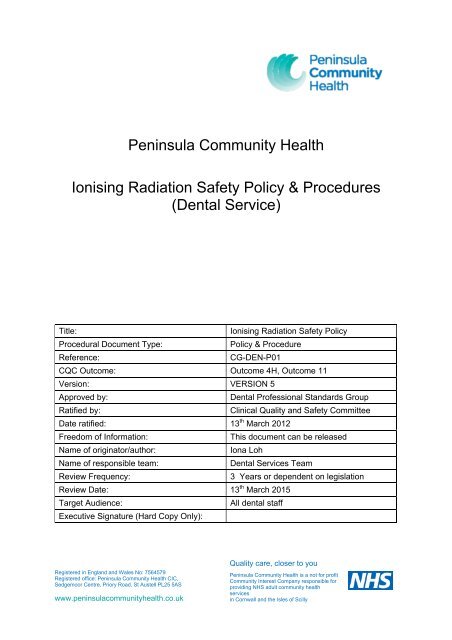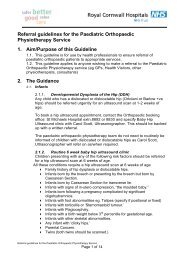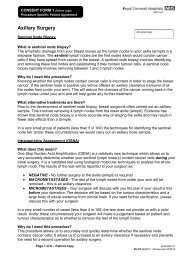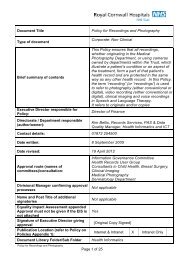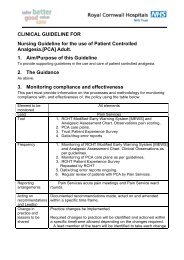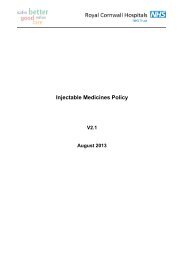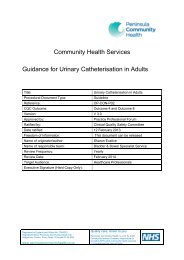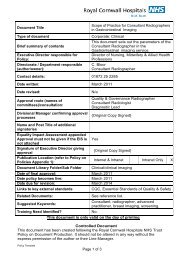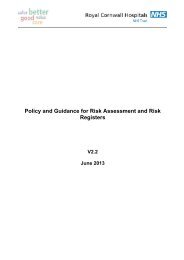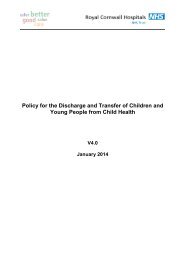Ionising Radiation Safety for Dental Services Policy
Ionising Radiation Safety for Dental Services Policy
Ionising Radiation Safety for Dental Services Policy
You also want an ePaper? Increase the reach of your titles
YUMPU automatically turns print PDFs into web optimized ePapers that Google loves.
Peninsula Community Health<strong>Ionising</strong> <strong>Radiation</strong> <strong>Safety</strong> <strong>Policy</strong> & Procedures(<strong>Dental</strong> Service)Title:<strong>Ionising</strong> <strong>Radiation</strong> <strong>Safety</strong> <strong>Policy</strong>Procedural Document Type:<strong>Policy</strong> & ProcedureReference:CG-DEN-P01CQC Outcome: Outcome 4H, Outcome 11Version: VERSION 5Approved by:<strong>Dental</strong> Professional Standards GroupRatified by:Clinical Quality and <strong>Safety</strong> CommitteeDate ratified: 13 th March 2012Freedom of In<strong>for</strong>mation:This document can be releasedName of originator/author:Iona LohName of responsible team:<strong>Dental</strong> <strong>Services</strong> TeamReview Frequency:3 Years or dependent on legislationReview Date: 13 th March 2015Target Audience:All dental staffExecutive Signature (Hard Copy Only):Registered in England and Wales No: 7564579Registered office: Peninsula Community Health CIC,Sedgemoor Centre, Priory Road, St Austell PL25 5ASwww.peninsulacommunityhealth.co.ukQuality care, closer to youPeninsula Community Health is a not <strong>for</strong> profitCommunity Interest Company responsible <strong>for</strong>providing NHS adult community healthservicesin Cornwall and the Isles of Scilly
Contents1 Introduction ........................................................................................................ 42 Scope................................................................................................................. 43 Statement of <strong>Policy</strong> ............................................................................................ 44 Definitions .......................................................................................................... 45 Duties................................................................................................................. 45.1 Duties of the Employer................................................................................. 55.2 Duties of the Person with Operational Responsibility <strong>for</strong> <strong>Radiation</strong> <strong>Safety</strong> .. 65.3 Duties of the RPS ........................................................................................ 75.4 Duty Holders under IRMER.......................................................................... 75.5 Duties of all Employees ............................................................................... 86 Quality Assurance .............................................................................................. 87 Selection, Replacement and Acceptance of <strong>Radiation</strong> Equipment..................... 88 Risk Management Strategy Implementation....................................................... 98.1 Implementation & Dissemination.................................................................. 98.2 Training and Support ................................................................................... 98.3 Document Control & Archiving Arrangements............................................ 108.4 Equality Impact Assessment...................................................................... 109 Process <strong>for</strong> Monitoring Effective Implementation ............................................. 1010 Associated Documentation............................................................................... 1111 References....................................................................................................... 1112 Employer’s IRMER Procedures........................................................................ 1212.1 Procedure to Identify Individuals Entitled to act asReferrer/Practitioner/Operator.......................................................................... 1212.2 Procedure <strong>for</strong> the Correct Identification of the Patient ........................ 1212.3 Procedure <strong>for</strong> Justification & Authorisation of Exposures ................... 1212.4 Procedure to be Observed in the Case of Medico-Legal Exposures .. 1312.5 Procedure <strong>for</strong> Medical Exposures of Women of Child Bearing Age.... 1312.6 Procedure <strong>for</strong> the Assessment of Patient Dose and AdministeredActivity AND Procedure <strong>for</strong> the Carrying out and Recording of an Evaluation <strong>for</strong>Each Medical Exposure.................................................................................... 1312.7 Procedure <strong>for</strong> the Establishment and use of Diagnostic ReferenceLevels. 1412.8 Procedure to Ensure That the Probability and Magnitude of Accidentalor Unintended Doses to Patients from Radiological Practices are Reduced sofar as Reasonably Practicable.......................................................................... 1412.9 Procedure To Ensure That Quality Assurance Programmes <strong>for</strong>Equipment & Standard Operating Procedures Are Followed. .......................... 1412.10 Procedure to Ensure That Duty Holders Are Adequately Trained....... 1412.11 Procedure <strong>for</strong> Clinical Audit ................................................................ 1512.12 Procedure <strong>for</strong> Maintaining an Equipment Inventory & Ensuring thatEquipment is Limited to the Amount Necessary <strong>for</strong> the Proper Carrying out ofMedical Exposures........................................................................................... 1512.13 Procedure <strong>for</strong> use of Intra-Oral X-ray Equipment................................ 15Appendix 1 Matters in respect of which a <strong>Radiation</strong> Protection Adviser must beconsulted by the Employer ....................................................................................... 172 of 17
Please Note the Intention of this DocumentThe policy details the management arrangements and responsibilities <strong>for</strong> radiation safety <strong>for</strong>Peninsula Community HealthReview and Amendment LogVersion No Type of Change Date Description of change1.0 New <strong>Policy</strong> 15/02/11 Creation of policy by R Cranage, T Foy andI Loh2.0 Formatting 14/12/11 Formatted into new PCH template3 of 17
1 IntroductionThis policy <strong>for</strong>ms part of the organisation’s arra ngements <strong>for</strong> health & safety as required bythe Health & <strong>Safety</strong> at Work etc. Act 1974. The policy details the management arrangementsand responsibilities <strong>for</strong> radiation safety <strong>for</strong> Pe ninsula Community Heal th <strong>Dental</strong> Service tosecure compliance with The <strong>Ionising</strong> <strong>Radiation</strong>s Regulations 1999 (IRR99) and The <strong>Ionising</strong><strong>Radiation</strong> (Medical Exposure) Regulations 2000 (IRMER). Failure to comply with this policymay lead to disciplinary action and prosecution of the employer or individual.2 ScopeThis policy applies to a ll employees of Peninsula Commu nity Health (PCH) on t he sitesnamed on the front pa ge of this policy. The sites on which the <strong>Dental</strong> Service utilisesionising radiation are listed in appendix 3.3 Statement of <strong>Policy</strong>The organisation will ensure, as far as is reason ably practicable, that appropriate measuresare taken to secure the health and safety of its e mployees, patients, contractors working onits premises and me mbers of the public (inclu ding the families of patients) who may beexposed to the hazards arising from the use of ionising radiation.The organisation is committed to a policy of restricting expo sures to ionising radiation to AsLow As Reasonable Practicable (ALARP), social economic factors being taken into account.To effect this the organisation will maintain a radiation pro tection management structure toimplement radiation safety requirements.The organisation will en sure that a ll diagnostic examinations involving medical exposuresare per<strong>for</strong>med with the radiation dose to the patient being as low as reasonably practicable(ALARP) to achieve the required clinical purp ose, consistent with the employer’s writtenprocedures and protocols.4 DefinitionsReferrer: The referrer is responsible <strong>for</strong> working within the organisation’s referral criteria and<strong>for</strong> providing adequate written clin ical in<strong>for</strong>mation to ena ble the pat ient to be correctlyidentified and to enable the practitioner to justify the medical exposure(s) requested.Practitioner: The practitioner is resp onsible <strong>for</strong> justifying medical exposures and, within theextent of their involvement, keeping the dose to the patient as low as reasonable pra cticableconsistent with the intended purpose.Operator: The operator is any p erson who carries out practical aspects of a medicalexposure and is re sponsible <strong>for</strong> ensuring that, within the extent of th eir involvement, theykeep the dose to the patient as low as reasonable practicable consistent with the intendedpurpose.Medical Physics Expert: A Med ical Physics Expert (MPE) will be appointed by theorganisation and be available <strong>for</strong> consultation and support as appropriate <strong>for</strong>; justification,dose optimisation, pat ient dosimetry, equipment quality assurance relating to thedevelopment and use of new tec hniques and equipment, and other radiation protectionmatters concerning medical exposures.Employer: The employer is resp onsible <strong>for</strong> compliance with IRMER. The employer mustestablish procedures, diagnostic reference levels, appoint duty holders, provide training,maintain records et cetera as required by the legislation.4 of 17
<strong>Radiation</strong> Protection Adviser: A <strong>Radiation</strong> Protection Adviser (RPA) will be appoi nted bythe organisation and be available to advise on matters of radiation safety as required by th e<strong>Ionising</strong> <strong>Radiation</strong>s Regulations 1999.5 DutiesThis section includes a n overview of individual roles, departmental an d committee dutiesincluding levels of responsibility:5.1 Duties of the EmployerThe employer shall ap point a <strong>Radiation</strong> Protection Adviser (RPA) and Medical PhysicsExpert (MPE) to advise on all matters concerning the safe use of ionising radiations.The employer will ensure a medical physics service is engaged to provide equipment qualityassurance testing services.The employer will give the RPA and MPE po wer and su fficient resource (i.e. t ime andaccess to e quipment and staff) to inspect and per<strong>for</strong>m su ch tests or audits as th ey thinkappropriate to carry out their duties and support their work.The employer will, where required, appoint a <strong>Radiation</strong> Protection Supervisor (RPS) tooversee the safe use of radiation in compliance with the local rules. The RPA will a dvise onthe suitability of an individual to act as RPS.The employer, under ad vice from the RPA and MPE, shall undertake prior risk assessmentof all work activities involving io nising radiation, including subsequ ent review of thoseassessments.The employer, under a dvice from the RPA, where work is undertake n by pregnant orbreastfeeding member of staff shall undertake a risk assessment of that individual’s work.Where required, the employer unde r advice from the RPA must devise local rules to enablework with ionising radiation to be carried out in a safe manner.The employer will ensu re that all diagnostic medical exposures are per<strong>for</strong>med with theradiation dose to the patient being a s low as reasonably practicable to a chieve the requiredclinical purpose, consistent with the employer’s written procedures (contained in the secondhalf of this document).The employer will establish, as required by IRMER:• Patient referral criteria• Diagnostic Reference Levels (indicators of radiation dose in standard practice)• Written employer’s procedures as detailed in IRMER schedule 1.• Quality assurance procedures, including review of documentation and clinical audit.The employer shall ensure no pract itioner or operator shall carry out a medical exposure orany practical aspect without having been adequately trained.The employer, under a dvice from the RPA an d MPE, will ensure that staff working withionising radiation will be trained to a level comme nsurate with the work being per<strong>for</strong>med andthe degree of hazard involved and t o satisfy legal requirements. The employer sha ll ensurethat practitioners and operators undertake co ntinuing education and training, in cludingtraining related to new equipment and new clinical techniques (see section 12).5 of 17
Nothing in the two paragraphs abo ve shall prevent a person from participating in practicalaspects of the procedure as part of practical training if this is done under the supervision of aperson who themself is adequately trained.The employer shall ensure that a register of practitioners and operators is maintained. Thiswill consist of name, jo b title date of training, nature of training completed and extent ofduties under IRMER.This record shall be kept up to date and made available <strong>for</strong> inspection.The employer shall ensure and enable good communi cation & co-operation betweenadvisers and all employees on matters of radiation protection.The employer will esta blish good co-operation and communication wi th other employerswhose staff, in the cour se of their duties, may be exposed and/or placed at risk by th eorganisation’s radiation work.5.2 Duties of the Person with Operational Responsibility <strong>for</strong> <strong>Radiation</strong><strong>Safety</strong>The Clinical Director of the <strong>Dental</strong> Servic e acts on behalf of the employer to ensurethat the this policy <strong>for</strong> radiation s afety is implemented. This perso n must consult withstaff, the RPS and RPA. It ma y be in the futu re that a wider impleme ntation of x-rays ma ytake place with a more general installation of x-ray syste ms and equipment, where <strong>Dental</strong>may be involved. Then a different policy may be written.This person must:-Identify the clinics and areas of the dental service where x-ray sources are used, maintainingan up to date site list.Ensure employees are aware of the risks to th eir health and safety from ionising radiationand the precautions they must take to minimise those risks.Ensure that employees, who may be exposed to risks to their health and safety from ionisingradiation are provided with appropriate in<strong>for</strong>mation, instruction, training and supervision, andhave access to any personal protective equipment as may be required.Ensure, under advice from the RPA & MPE, tha t the organisation develops safe systems ofwork & local rules, as appropriate, <strong>for</strong> the safe use of ionising radiation.Ensure that radiation pr otection supervisors (RPS) are appointed in relevant work areas tomonitor application of the local rules and radiation protectio n standards, and to info rm andadvise staff on safe working practices.Ensure that appropriate arrangements are in place to monitor personal radiation doses andthat individual doses are within dose limits. Ensure that staff a aware of reportingmechanisms in the event of unintended or high doses being received.Ensure that an investigation is undertaken whenever a member of staff receives a dose thatexceeds the levels set in the local rules.Ensure that actual or su spected adverse events in which a patient or member of st aff mayhave received a dose much greater than intended are investigated and that the RPA i sin<strong>for</strong>med immediately and the internal incident reporting procedures are followed.Ensure that the RPA is consulted with regard to all matters required by t he legislation – seeappendix 1. In particular:-6 of 17
• The planning and purchase of all new and replacement facilities and/or equipmentthat utilise ionising radiation.• The planned use of any loan/hire/demonstration radiation equipment.Ensure that employees carrying out medical exposures are appropriately trained and followthe organisation’s operating procedures as required by IRMER.Ensure that referral criteria are established and made available to referrers.Ensure that persons referring patients <strong>for</strong> medical exposures are aware of their responsibilityunder this policy, particularly to act within the referral criteria and to provide sufficie nt writtenclinical in<strong>for</strong>mation so that each exposure can be justified.Ensure that written pro tocols (e.g. standard exposure time charts) are in pla ce <strong>for</strong> everystandard radiological practice.Ensure that a centrally held inventory of radiation equipment (includ ing film/CR processorsand digital sensors) is maintained. The inventory must include:• Type of equipment e.g.: sensor; scanner; phosphate plates• Name of manufacturer• Model number• Serial number or other unique identifier• Year of manufacture• Year of installation• Details of installers (where applicable)5.3 Duties of the RPSA <strong>Radiation</strong> Protection Supervisor (RPS) will be appointed in writing by the employer, underadvice from the RPA, <strong>for</strong> areas in which w ork activities are unde rtaken with ionisingradiation.The <strong>Radiation</strong> Protectio n Supervisor (RPS) will supervise work with ionising radiation toensure it is done in accordance with the local rules. They must be suitably trained to per<strong>for</strong>mtheir role.The RPS must be familiar with the requirements of the local rules, relevant parts of the<strong>Ionising</strong> radiation Regulations 1999 and it’s Approved Cod e of Practice. The RPS shouldalso have a working knowledge of the RCS Guidelines.The duties carried out by the RPS will be detailed in the appropriate local rules.5.4 Duty Holders under IRMERThe <strong>Ionising</strong> <strong>Radiation</strong> (Medical Exposure) Regulations 2000 define certain legal dutyholders (roles) associated with the process of carrying out medical exposures.The roles of the duty holders are detailed in the employer’s IRMER procedures.These include a procedure to identify those persons wit hin the organisation w ho areauthorised to per<strong>for</strong>m each role (i.e. to act as a particular IRMER duty holder).Medical exposures sh all only be conducted in accorda nce with the employer’ s IRMERprocedures, by persons authorised to do so as set out within those procedures.7 of 17
5.5 Duties of all EmployeesFor medical exposures, recognise duties and responsibilities they hold when acting as dutyholder under IRMER (e.g. acting as practitioner or operator).Exercise reasonable care in carrying out their duties and follow the relevant Local Rules.Use, as instructed, any protective equipment and personal dosimeters provided by theemployer.Comply with the employer’s procedures and protocols <strong>for</strong> medical exposures in line withRCS Guidelines.Undertake instruction and training as directed by the employer.Report any faults in equipment, facilities or pro cedures that may adversely affect the healthand safety of any person, or any untoward radiation exposure of an individual.Report any incident in which a patient ma y have received a radiation exposure greater thanintended on the PCH Datix reporting system.Upon becoming aware that they are pregnant, immediately in<strong>for</strong>m their line mwriting so that an individual risk assessment can be per<strong>for</strong>med.anager in6 Quality AssuranceNB. See also section 12.9 with regard to Quality Assurance of proceduresAny equipment or appa ratus used in connection with medical exposur es will, as far asreasonably practicable, be selecte d, installed and maintained so th at it is capable ofrestricting the exposure of the patient in accordance with the intended clinical purpose.User quality assurance tests will be carried out at regular intervals in accordance with advicefrom the RPA and MPE in order t o meet legi slation and recommended standards, on allequipment or apparatus involved in patient exposures wit h ionising r adiation. R ecord ofthese tests shall be maintained on a standard <strong>for</strong>m held alongside the local rules.Quality assurance test s will be ca rried out by the <strong>Radiation</strong> Protectio n Service at periodicintervals, as directed by the RPA and MPE. The employer shall respond expeditiously to thefindings and recommendations of these inspections.Upon maintenance, modification , relocation or repair of x-ray/imaging equipment beingundertaken by an y person, the employer a nd/or RPS shall ensure that the <strong>Radiation</strong>Protection Service are contacted, prior to the return of the equipment to clin ical use, todetermine if equipment per<strong>for</strong>mance testing or other inspection is required. An eq uipmenthandover/handback <strong>for</strong>m shall be completed and held alongside the local rules.7 Selection, Replacement and Acceptance of <strong>Radiation</strong> EquipmentMedical radiation equipment will be selected to keep th e dose as low as rea sonablypracticable consistent with the intended purpose.The organisation will <strong>for</strong> mulate a programme fo r the progressive replacement of equipmentwhose per<strong>for</strong>mance has deteriorated or does not con<strong>for</strong>m to current standards or guidance.8 of 17
The employer must engage in prior consultation with the RPA andselection, purchase and replacement of radiation equipment.MPE regarding theDuring installation of equipment that emits ionising radiation, the installer in accordance withtheir legal duty will carry out a critical examination of equipment be<strong>for</strong>e it is used onpatients. The installers shall consu lt with the RPA regarding the scope of tests and findingsof that critical examination. The eq uipment may not be used <strong>for</strong> any purpose until the RPAis satisfied with the results of the critical examination.All imaging equipment shall unde rgo acceptance testing by the <strong>Radiation</strong> ProtectionService prior to first clinical use – including CR/film processors and digital sensors.Equipment shall not b e brought on to site by staff or manufacturers etc, fo r loan,demonstration, trial or t esting purposes without prior consultation with the RPA so that therelevant statutory provisions such as notification to HSE, prior risk assessment etc. can besatisfied.The supplier of the equipment is responsible <strong>for</strong> providing details to the employer concerningthe necessary safety arrangements including: do cumentation proving that the equipment issafe to use and describing the necessary safe working procedures, testing and mai ntenancerequirements of the equipment whilst on loan, and details of any additional person al safetyequipment and staff training that might be necessary.8 Risk Management Strategy Implementation8.1 Implementation & DisseminationPeninsula Community Health is responsible <strong>for</strong> ensuring that the D ental Servicecomplies with the requirements of the legi slation surrounding the use of ionisingradiations within the organisation. This responsibility cannot be delegated.The Clinical Director of the <strong>Dental</strong> Service is to be identified in the organisation asthe member with operational respo nsibility <strong>for</strong> <strong>Radiation</strong> <strong>Safety</strong> within the <strong>Dental</strong>Service.Employees must ensure that they comply with all relevant policies an d procedureswhen undertaking any activity involving the use of ionising radiations.The <strong>Radiation</strong> Protection Adviser (RPA) is appointed by the organisation to adviseon compliance with the <strong>Ionising</strong> <strong>Radiation</strong>s Regulations 1999. They should b econsulted on all matters related to the regulations.The Medical Physics Expert (MPE) is appointed by the organisation <strong>for</strong> th epurposes of the <strong>Ionising</strong> <strong>Radiation</strong> (Medical Exposure) Regulations 2000 to advise onoptimisation, patient dosimetry, quality assu rance and radiation protection in medicalexposures.The <strong>Radiation</strong> Protection Supervisor (RPS) is responsible focompliance with the Local Rules in areas which they are appointed.r supervising8.2 Training and SupportGeneral: Staff working with ionising radiation will receive training commensurate withthe work being per<strong>for</strong>med and the degree of hazard involved.9 of 17
Appropriate training in the correct use of new equipment will be given to st aff asrequired.No person will be appointed as a R adiation Protection Supervisor unless they knowand understand radiation protection principles and procedures, the requirements ofthe Regulations and the arrangeme nts in the local rules to enable them to supervisethe work safely and maintain the precautions necessary to restrict exposure.Medical Exposures: All IRMER p ractitioners and operators must have receive dadequate up to date training as defined within the employer’s IRMER procedures andin accordance with GDC regulations.8.3 Document Control & Archiving ArrangementsOnce ratified, this poli cy will be lo aded to the documents library. A ny previousversions will be electronically archived by the <strong>Policy</strong> Administrator in the electroni c<strong>Policy</strong> Drive Archive Folder.A signed hard copy of the policy will be <strong>for</strong>warded to the <strong>Policy</strong> Administrator and a nelectronic copy will be saved by the <strong>Policy</strong> Administrator in the ele ctronic <strong>Policy</strong>Drive. Further copie s of current and archived policies ca n be obta ined from th e<strong>Policy</strong> Administrator including versions in large print, Braille and other languages.8.4 Equality Impact AssessmentPeninsula Community Health aims t o design an d implement services, policies andmeasures that meet the diverse needs of our service, po pulation and work<strong>for</strong>ce,ensuring that none are placed at a disadvantage over others.As part of its development, this strategy and its impact on equalit y have beenassessed. The assessment is to minimise and if possible remove anydisproportionate impact on employees on the grounds of race sex, di sability, age,sexual orientation or religious belief. No detriment was identified.9 Process <strong>for</strong> Monitoring Effective ImplementationThe arrangements <strong>for</strong> radiation protection (this policy, local rules, risk assessments) will bemonitored by:The programme of rad iological equipment testing and th e issue of written reports. Thewritten reports will be sent to the lo cal member of staff in charge and the RPA and MPE asappropriate.Periodic review of this p olicy, local rules, risk assessments and other o perating procedureson a 3 yearly basis, with immediate review if failures of process are identified.Managers, ensuring th at radiation protection responsibilities are included in personaldevelopment review and personal objectives of their staff.The radiation protection supervisors annual written audit fe edback to t he RPA wh ich willinclude summaries of significant non-compliances and incidents.Any further audit measures as may be periodically recommended by the RPA and MPE.10 of 17
10 Associated DocumentationThis document references the fo llowing supporting documents which should b ereferred to in conjunction with the document being developed.11 ReferencesWork with ionising radiation, Approved Code of Practice and Guidance, The<strong>Ionising</strong> <strong>Radiation</strong>s Regulations 1999. HMSO 1999Medical and <strong>Dental</strong> Guidance Notes. A good practice guide to implement ionisingradiation protection in the clinical environment. Institute of Physics in Engineeringand Medicine 2002Guidance Notes <strong>for</strong> <strong>Dental</strong> Practitioners on the Safe Use of X-ray Equipment.Department of Health 2001.Equipment used in connection with medical exposure, Guidance Note PM77(third edition). HSE 2006.Making the Best Use of a Department of Clinical Radiology. Guidelines <strong>for</strong>Doctors. Royal College of Radiologists (fifth edition) 2003.Working safely with ionising radiation: guidelines <strong>for</strong> expectant or breastfeedingmothers. HSE INDG334 03/01 C400.The regulatory requirements <strong>for</strong> medical exposure to ionising radiation. Anemployer’s overview HSG223. HSE books 2001Selection Criteria <strong>for</strong> <strong>Dental</strong> Radiography Faculty of General <strong>Dental</strong> Practitioners (UK) RCSEng FGDP (UK) Good Practice Guidelines 2004The Health and <strong>Safety</strong> at Work Act, 1974The <strong>Ionising</strong> <strong>Radiation</strong>s Regulations 1999 (SI 1999 No 3232)The <strong>Ionising</strong> <strong>Radiation</strong> (Medical Exposures) Regulations 2000. (SI 2000 No 1059)Management of Health & <strong>Safety</strong> at Work Regulations 1999 (SI 1999 No 3242)The Control of Artificial Optical <strong>Radiation</strong> at Work Regulations 201011 of 17
12 Employer’s IRMER ProceduresIntroduction: These procedures set out the employer’ s arrangements to fulfil th erequirements set out in Schedule 1 of the <strong>Ionising</strong> <strong>Radiation</strong> (Medical Exposure) Regulations2000. These procedures apply to all medical exposures carried out within the organisation.An individual may per<strong>for</strong>m one or many roles dependen t upon their qualifications andposition within the organisation. For example, a dentist might act as a Referrer, Practitionerand Operator as well. See Definitions section.12.1 Procedure to Identify Individuals Entitled to act asReferrer/Practitioner/OperatorAll members of staff a cting as IRMER ‘duty holders’ (i.e. per<strong>for</strong>ming one of the identifiedroles) must do so as d etailed under these procedures. F ailure to do so would result in abreach of the regulations and may be treated as a disciplinary offence.The following are entitled to a ct as referre rs in a ccordance with these pro cedures:<strong>Dental</strong> practitioners who have received, read and understood the emplo yer’s referral criteria<strong>for</strong> dental x-ray.The following are entitled to act as practitioners in accordance with these procedures:<strong>Dental</strong> Practitioners wh o have evid enced appropriate training and be en recorded on theemployer’s register of practitioners.The following are entitled to act as operat ors in accordance wit h these pr ocedures:<strong>Dental</strong> Practitioners, <strong>Dental</strong> Nurses or D ental Therapists who have evidenced ap propriateinitial and update training.For equipment testing purposes only (excludes patient exposure) the following areauthorised to operate the equipment:The employer’s staff who have received adequate training.Medical physics staff.X-ray equipment engineers.Unless otherwise indicated above, students/trainees may not act a s the duty hold er whencarrying out any such task (e.g. just ification or practical aspects of the exposure), they mustbe directly supervised by an individ ual entitled (in accordance with this procedure, above) toact as the duty holder. In such cases the supervisor acts as duty holder – i. e. takesresponsibility, and this must be documented accordingly – <strong>for</strong> exa mple supervisor is t orecord ‘checked’ plus signature in patient notes.12.2 Procedure <strong>for</strong> the Correct Identification of the PatientThe operator will verify that they have the corre ct patient prior to making any exposure bychecking the patient’s name, address and date of birth against the patient’s record.12.3 Procedure <strong>for</strong> Justification & Authorisation of ExposuresJustification of intra-oral and OPT exposures is carried out by the practitioner.12 of 17
A suitable record of justification shall be made in the patient electronic notes using the x-rayexposure record box on the patient record sy stem. This shall include the x-ray view anddescription of the justification – thr ough use of the free text field or, only where ap propriate,through use of the co mmonly occurring reasons (drop down box). No study shall berecorded as ‘routine bitewings’ etc.; <strong>for</strong> exa minations carried out on a periodic basis thejustification <strong>for</strong> the individual exposure shall be considered and recorded.In carrying out the just ification the practitioner needs to consider the individual needs of thepatient - the benefits of carrying out the exposure and any potential det riment to the patientfrom the exposure.Authorisation <strong>for</strong> exposures to be undertaken by the Operator is indica ted by the act of entryof justification into the patient’s notes.On any (rare) occasion where justification is recorded but the Practitioner wishes to delayauthorisation of the exa mination (e.g. to counsel/reassure the patient) this reason shall berecorded alongside the justification and ‘NOT AUTHORISED – DO NOT PERFORM’. Asubsequent ‘AUTHORISED’ note shall be recorded once authorisation is granted.12.4 Procedure to be Observed in the Case of Medico-Legal ExposuresMedico-legal procedures shall not be per<strong>for</strong>med by the organisation.12.5 Procedure <strong>for</strong> Medical Exposures of Women of Child Bearing AgeFor the purposes of these procedures, women of childbearing age are females between theages of twelve and fifty-five. Always double check via medical history.<strong>Dental</strong> x-ray exposures do not directly irradiate the abdomen, and, as such, are considered a“low dose” examination by the Health Protection Agency. <strong>Dental</strong> exposures may there<strong>for</strong>e beper<strong>for</strong>med during pregnancy.Verify pregnancy status with reference to the patient’s medical history. In cases ofpregnancy in order to r educe any dose to the f oetus as far as reasonably practicable, everycare must be taken not to direct the primary beam to wards the abdomen of a pregnantwoman.12.6 Procedure <strong>for</strong> the Assessment of Patient Dose and AdministeredActivity AND Procedure <strong>for</strong> the Carrying out and Recording of anEvaluation <strong>for</strong> Each Medical ExposureThe dental practitioner will record the type and number of exposures undertaken using the x-ray record box on the patient in<strong>for</strong> mation system. The dose at the tip of the cone <strong>for</strong> eachexposure setting is provided by the physics service and thus this in<strong>for</strong>mation is adeq uate toallow the dose to any patient to be estimated.The clinical evaluation of an exposure will be recorded in the x-ray record by th e dentalpractitioner, e.g. “Bitewings show int erproximal caries between LR6 and LR5”, “DPT showsall teeth present up to and including eights” or, only where appropriate, through use of thedrop-down box of common responses.13 of 17
12.7 Procedure <strong>for</strong> the Establishment and use of Diagnostic ReferenceLevels.Routine equipment tests provided by the physics service will establish d iagnostic referencelevels <strong>for</strong> st andard radiological pra ctices – u sually in the <strong>for</strong>m of a ‘standard’ exposuretime/dose chart. This chart is to be displayed on wall with the local rules.These factors are not expected to be exceeded <strong>for</strong> standard procedures and when good andnormal practice regarding diagnostic and technical per<strong>for</strong>mance is applied.Where the operator notes that these factors are being consistently exceed, this shall beimmediately reported on the CHS i ncident reporting system and to the radiation protectionservice; the radiation protection service shall investigate and remedial action be taken.No person shall adju st the exposure programmes set on the x-ray set (or whereprogrammed manually by the operator, the reference table of exposu re times) without firstcontacting the radiation protection service.12.8 Procedure to Ensure That the Probability and Magnitude ofAccidental or Unintended Doses to Patients from RadiologicalPractices are Reduced so far as Reasonably Practicable.All x-ray a nd associated equipment is subject to appro priate maintenance and QualityAssurance procedures.All medical exposures must be per<strong>for</strong>med in a ccordance with these procedures. It would b edeemed a disciplinary offence <strong>for</strong> anyone otherwise to carry out an exposure. All dutyholders acting under these procedures must be adequately trained and updated.Should however, there be an incid ent resulting in an appar ent or suspected overexposure,the operator must ens ure that appropriate incident repo rting processes are f ollowed,including consultation with the <strong>Radiation</strong> Protection Advisor (RPA). Where such incidentsresult in a dose “much greater than intended”, the RPA will advise on appropriate action.12.9 Procedure To Ensure That Quality Assurance Programmes <strong>for</strong>Equipment & Standard Operating Procedures Are Followed.Standard procedures will be reviewed at least three yearly and updated as require d by theemployer. Updated documents will be circulate d to all staff by the employer, and previousversions removed.All staff will be remind ed of their responsibilities regarding training and maintaining theirpractice at annual appraisal.Compliance with procedures will be subject to annual audit.Periodic equipment per<strong>for</strong>mance tests are provi ded by the Medical Ph ysics Service. TheMedical Physics Service shall ensure procedures are in place <strong>for</strong> the rou tine testing of X rayand associated equipment, including procedures to address test results that are outside ofthe defined limits.12.10 Procedure to Ensure That Duty Holders Are Adequately TrainedAll dentists must hold an annual practicing certificate issued by the Ge neral <strong>Dental</strong> Council(GDC), including the requirement to update knowledge on radiation protectio n issuescontained in the GDC’s mandatory core Continuing Professional Development programme.14 of 17
All other duty holders must maintain professiona l registration and have received appropriatetraining commensurate with the pr actical tasks that they will undertake. They must alsoundertake appropriate update training.The employer must ensure records of such training are held and updated.12.11 Procedure <strong>for</strong> Clinical AuditPeriodically, clinical audit will be carried out. This will include audit of compliance with theseprocedures, and on the recording and quality of exposures.To assess image quality, a sa mple of exposures acquired at standard exposure factors willbe assessed. each image is evaluated on an “123” rating, of which “1” means entirelysatisfactory, “2” means that some errors may be identified , none of wh ich detract from thediagnostic utility of the radiograph, and “3” is unsatisfa ctory to the e xtent that the exposurehas to be repeated and is of no diagnostic value.To assess compliance with diagnostic reference levels (DRLs), <strong>for</strong> a sample of exposuresalready undertaken the recorded e xposure shall be compared against the corre spondingDRL.The results of such audits shall be supplied to the RPA and MPE.12.12 Procedure <strong>for</strong> Maintaining an Equipment Inventory & Ensuringthat Equipment is Limited to the Amount Necessary <strong>for</strong> the ProperCarrying out of Medical ExposuresAn inventory of X-ray and associated equipment is to be maintained by the employer.The employer shall discuss with the RPA and MPE the suitability of any proposed p urchaseof equipment or use of lease/loan/hire/demonstration equipment.Should any item of equipment become disused, the employer shall discuss the appropriatestorage and disposal with the RPA.12.13 Procedure <strong>for</strong> use of Intra-Oral X-ray EquipmentThe Operator must position the ima ge receptor in the patient’s mouth an d position the coneto ensure t he x-ray be am is appropriately al igned to the image receptor. Positional aidsshould be used wherever possible.The cone should normally be provided with re ctangular collimation, but this i n exceptionalcircumstances may be removed if the Operator believes that, despite good radio graphicpractice, the likelihood of a repeat exposure outweighs the benefit o f reducing t he beamarea.Once the receptor and cone have been appropriately positioned, the Operator must retreatto a safe distance as defined in the Local Rules. The Operator should ensure that the patientcan be adequately observed during the exposure.The Operator must select exposure parameters appropria te to the re quired radiographicview – <strong>for</strong> b itewing select the bitewing setting e tc. The Operator must verify the expectedexposure time is displayed (compare with standard e xposure programmes/diagnosticreference levels).15 of 17
The Operator carrying out the exposure must ma ke a final check o f the equipment settingsand patient be<strong>for</strong>e pressing the exposure switch.Students/trainees may undertake any of the above tasks under supervision of theappropriate duty holder.16 of 17
Appendix 1 Matters in respect of which a <strong>Radiation</strong> ProtectionAdviser must be consulted by the Employer(As set out in The <strong>Ionising</strong> <strong>Radiation</strong>s Regulations 1999)1) The implementation of requirements as to controlled and supervised areas.2) The prior examination of plans <strong>for</strong> installations and the acceptance into service ofnew or modified sources of ionising radiation in relation to any engineering controls,design features, safety features and warning devices provided to restrict exposure toionising radiation.3) The regular calibration of equipment provided <strong>for</strong> monitoring levels of ionisingradiation and the regular checking that such equipment is serviceable and correctlyused.4) The periodic examination and testing of engineering controls, design features, safetyfeatures and warning devices and regular checking of systems of work provided torestrict exposure to ionising radiation. (i.e. periodic reviews of departments usingionising radiation).In addition, the employer is required to consult an RPA on the following matters:• Risk assessments, and contingency plans if necessary.• The <strong>for</strong>m and content of local rules <strong>for</strong> each designated controlled or supervisedarea.• The conduct of investigations and subsequent reports required by the regulations,including staff and patient overexposure.• Dose assessment and recording, including personal and area monitoring.• The selection and use of appropriate personal protective equipment.• Critical examinations of newly installed or repaired equipment and articles <strong>for</strong> workwith ionising radiation.• Quality assurance programmes <strong>for</strong> medical radiation equipment.• Arrangements <strong>for</strong> outside workers and the designation of employees as a classifiedpersons.• Staff training as appropriate <strong>for</strong> classified persons, outside workers, those who entercontrolled areas under written arrangements, other staff as necessary, safetyrepresentatives, radiation protection supervisors, staff undertaking monitoring,supervisors and managers with specific radiation responsibilities.• Prior authorisation, the use of new or revised procedures involving ionising radiation.• In<strong>for</strong>mation and instructions <strong>for</strong> pregnant employees.• Training <strong>for</strong> emergencies.The selection, appointment and training of <strong>Radiation</strong> Protection Supervisors.17 of 17
Equality Impact Assessment ToolTo be completed and attached to any procedural document when submitted to theappropriate committee <strong>for</strong> consideration and approval.Yes √No XComments1. Does the document/guidance affect onegroup less or more favourably than anotheron the basis of: Race X Ethnic origins (including gypsies andtravellers)X Nationality X Gender X Culture X Religion or belief XSexual orientation including lesbian, gay,transgender and bisexual peopleX Age X Disability - learning disabilities, physicaldisability, sensory impairment and mentalhealth problems2. Is there any evidence that some groups areaffected differently?3. If you have identified potentialdiscrimination, are there any exceptionsvalid, legal and/or justifiable?4. Is the impact of the document/guidancelikely to be negative?XXXX5. If so, can the impact be avoided? N/A6. What alternative is there to achieving thedocument/guidance without the impact?7. Can we reduce the impact by takingdifferent action?N/AN/AIf you have identified a potential discriminatory impact of this procedural document, pleaserefer it to the Equality and Diversity lead, together with any suggestions as to the actionrequired to avoid/reduce this impact.For advice in respect of answering the above questions, please contact the Equality andDiversity lead.V1-0 Page 1 of 1 17-Jul-12


